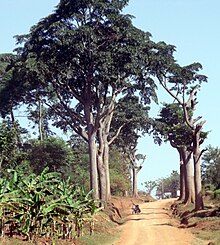Iroko
| Iroko | |
|---|---|

| |
| Milicia excelsa, Uganda | |
| Scientific classification | |
| Kingdom: | Plantae |
| Clade: | Tracheophytes |
| Clade: | Angiosperms |
| Clade: | Eudicots |
| Clade: | Rosids |
| Order: | Rosales |
| Family: | Moraceae |
| Tribe: | Moreae |
| Genus: | Milicia
Sim |
| Species | |

Iroko (also known as ọ́jị̀ in Igbo language, uloho in the Urhobo language of Southern Nigeria, and as odum in the Kwa languages of Ghana[1]) is a large hardwood tree from the west coast of tropical Africa that can live up to 500 years.[2] This is the common name for the genus Milicia, in which there are two recognized species, which are closely related: Milicia excelsa and Milicia regia.[3]
The genus name of Milicia is in honour of Milici (19th and 20th centuries), an administrator in Portuguese East Africa (in modern-day Mozambique) who supported the work of the author of the genus, Thomas Robertson Sim.[4] It was first described and published in Forest Fl. Port. E. Afr. on page 97 in 1909.[5]
The tree is known to the Yoruba as ìrókò, logo or loko and is believed to have healing properties.[6] Iroko is known to the Igbo people as ọjị wood.[7] It is one of the woods sometimes referred to as African teak,[8] although it is unrelated to the teak family. The wood colour is initially yellow but darkens to a richer copper brown over time.
Species
Iroko is yielded mostly (probably) by
Milicia excelsa is currently listed as 'near threatened' on the IUCN Red List.[11]
Both species are
Uses

The timber is used for a variety of external and internal purposes
It is a very durable wood;[16] iroko does not require regular treatment with oil or varnish when used outdoors, although it is very difficult to work with tools as it tends to splinter easily, and blunts tools very quickly.[17]
In the UK there are no trade restrictions on the machining of this timber. The only reported adverse effects known to be caused by the dust from iroko are asthma, dermatitis and nettle rash.[18]
Cultural beliefs
The tree is feared in some cultures where it originates and hence is shunned or revered with offerings.[19] Yoruba people believe that the tree is inhabited by a spirit, and anybody who sees the Iroko-man face to face becomes insane and speedily dies.[20] According to the Yoruba, any man who cuts down any iroko tree causes devastating misfortune on himself and all of his family,[20] although if they need to cut down the tree they can make a prayer afterwards to protect themselves.[21]
They also claim that the spirit of the Iroko can be heard in houses which use iroko wood, as the spirit of the Iroko is trapped in the wood.[20] In Nigeria the iroko wood is of much lower quality due to soil conditions as well as root-rot.[22][23][24] Some Westerners refer to the wood as "poor man's teak".[25]
Gallery
References
- ISBN 9780759104655.
- ISBN 9781460224274.
- S2CID 43985297
- S2CID 187926901. Retrieved 1 January 2021.
- ^ "Milicia Sim | Plants of the World Online | Kew Science". Plants of the World Online. Retrieved 26 October 2021.
- ISBN 9781498235822.
- ISBN 9781434953964.
- ^ Stephen (14 June 2023). "Iroko Wood Is African Teak Lumber 2023". Retrieved 20 June 2023.
- ^ iroko wood at the Encyclopædia Britannica
- ^ "Chlorophora excelsa (Welw.) Benth". Integrated Taxonomic Information System.
- . Retrieved 1 April 2024.
- PMID 24549110.
- ^ "Wood Species Database: Iroko". Wood Species Database. Timber Research And Development Association (TRADA). Retrieved 21 August 2022.
- ^ "La txalaparta, el sonido ancestral de Euskadi por Pol Ducable Rogés". CANCIONEROS.COM. Retrieved 4 March 2016.
- ISBN 9780275976798.
- ISBN 9788096886845.
- ISBN 9781408159095.
- ^ "HSE Toxic Woods Information Sheet" (PDF). Health and Safety Executive. Archived from the original (PDF) on 17 August 2021. Retrieved 15 October 2012.
- ^ Twilight Tales3. CUP Archive. 1953. p. 26. Retrieved 2 April 2011.
- ^ ISBN 978-1-60506-017-0.
- ^ The Church Missionary Juvenile Instructor. Seeley, Jackson, & Halliday. 1 January 1880.
- ^ Bulletin of the Imperial Institute. The Institute. 1 January 1914. p. 366.
- ^ Commons, Great Britain Parliament House of (1 January 1914). House of Commons Papers. H.M. Stationery Office.
- ^ Documentation and Information: Ecology : Catalogue of Documents and Publications on MAB in Africa. UNESCO's Regional Office. 1 January 1990.
- ISBN 9781477238844.
External links
- Toxic woods Archived 17 August 2021 at the Wayback Machine (HSE)
